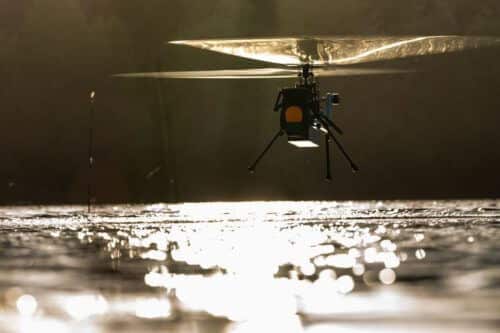An autonomous military drone that is pulled out of a soldier's backpack in moments of need, a robot dog that patrols around the base for security purposes - these are two recent developments, what can they indicate about what is expected of us?

Today's story is about two ghosts - ghosts in English. Both, by the way, are completely real. They and their close families are about to change the way we see the battlefield and the way wars are fought.
The first wind is actually a drone that looks like a tiny two meter long helicopter. Product name: Ghost 4. It can be folded to a size that fits in a combat soldier's backpack, and from there it can only be pulled out when needed.
But what are these moments of need? What can she do?
This is where things get interesting, because the system's capabilities are extremely diverse. The new drones are able to stay in the air for a hundred minutes, when controlled by a pilot - or move on their own completely autonomously. They can also carry a wide variety of payloads, including systems to jam enemy frequencies, an infrared laser to be used to direct other weapons to a target, and in theory – even its own weapon. All these abilities earned Spirit-4 the nickname "The army's Swiss army knife that can do it all".
There's another interesting thing about Spirit-4, but we'll save it for last. I want to address the second wind first. These are robotic dogs developed and produced by the company Ghost Robotics - robotics of spirits, in a particularly bad literal translation. These dogs were recently tested at a US Air Force base. They patrolled around the base and surveyed the area in daylight and in the dark of night. They don't carry weapons - at least not right now - but the company emphasizes that it can adapt them for any purpose, and change the sensors they carry and even the size of the robot to suit the needs of the task[2].

Why do we need these robots? The Assistant Secretary of the Air Force explained that future battlefields will be characterized by "information saturation". The goal will be to obtain as much information as possible, in order to make the most correct decisions in any situation. And if this means that robots are required that can patrol around the bases non-stop, what good.
The question arises against which enemy the United States is preparing to use these two spirits - and all the other robots it is developing and about to bring to the battlefield. We can find the answer from the drone at the beginning of the entry - Spirit-4. The manufacturer of the drone announced in Rish Gali that all the components used in the production of the drone come from the United States or its allies. What country are they not from? from china And this is not surprising, because last week China banned the export of several components found in many drones.
We see again how the new lines are drawn between the United States and its allies, and the Far East, led by China. These two superpowers - along with Russia, of course - are investing billions of dollars in artificial intelligence and robotics, and they are all preparing for a new kind of war. It will be a war in which robots will take the place of some soldiers in the field, and will receive express permission to kill enemy soldiers even without individual human approval for each and every soldier. This will be a war in which the robot's speed of response and data processing ability will determine whether it will be able to analyze the situation and react quickly enough - or whether it will give way to a faster and more aggressive robot. It is a war of armaments and development of robots on the battlefield, and all the powers are now in full swing.
The founder of the company that developed Ruh-4 He summarized his position in the following words: "I don't think we can win an AI arms race just by thinking it's not going to happen."
Well, here it is. The spirits in the machine begin to arrive on the battlefield.
In the coming days I will continue to review some more developments in the field of military robotics at sea, on land and in the air, and finally we will also talk about the meanings that all these robots can have on the nature of war itself. Will be interesting.
More of the topic in Hayadan:

2 תגובות
Nativity.
I understand that you prefer your children to be on the battlefield instead of the robots.
What a refreshing news, to all the spirits in the machine!
There really was a two-thousand-year-old hope that mechanical dogs would lick our blood and that faceless drones would locate us and shoot us with scientific precision. And here it is - the vision of the generations is coming true: no longer will we stand in front of Shlomiel soldiers like us, who were recruited at heart and their hands tremble when they press the trigger. no and no ! We, unlike our ancestors, will be destroyed more thoroughly!
There is something to live for.